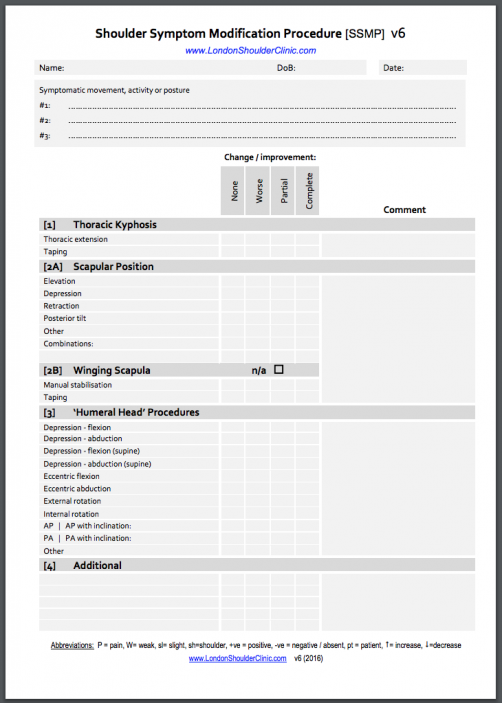Shoulder Symptom Modification Procedure: Difference between revisions
Rachael Lowe (talk | contribs) mNo edit summary |
Rachael Lowe (talk | contribs) mNo edit summary |
||
| Line 5: | Line 5: | ||
</div> <div align="justify"> | </div> <div align="justify"> | ||
== Introduction == | == Introduction == | ||
Current orthopaedic tests for [[Subacromial Pain Sydrome|rotator cuff pathology and subacromial pain syndrome]] demonstrate low specificities and inadequate likelihood ratios, cannot isolate individual tendons and other structures to inform an accurate diagnosis and are unable to inform clinical decision making and patient management<ref>Hegedus, E. J., Goode, A., and Campbell, S. (2008) Physical examination of the shoulder: a systematic review with meta-analysis of individual tests. British Journal of Sports Medicine, Vol. 42, pp. 80-92</ref><ref>Hughes, C. P., Taylor, N. F., and Green, R. A. (2008) Most clinical tests cannot accurately diagnose rotator cuff pathology: a systematic review. Australian Journal of Physiotherapy, Vol. 54, pp. 159-170</ref><ref name=":1">Lewis, J. S. (2009) Rotator cuff tendinopathy/subacromial impingement syndrome: is it time for a new method of assessment? British Journal of Sports Medicine, Vol 43, pp. 259-264</ref><ref>Lewis JS, Tennent TD. How effective are diagnostic tests for the assessment of rotator cuff disease of the shoulder? In: MacAuley D, Best TM, editors. Evidenced Based Sports Medicine. 2nd ed. London: Blackwell Publishing; 2007.</ref>. They should therefore be used in conjunction with a full subjective history and objective examination for comparable signs. | |||
, | |||
</ref>. | |||
Described by Jeremy Lewis in 2009<ref name=":1" /> the Shoulder Symptom Modification Tool (SSMP) is an approach to the assessment of individuals with [[Subacromial Pain Sydrome|rotator cuff and subacromial pathology]]. SSMP is a set of four mechanical techniques used in a sequence while the patient performs a movement that reproduces their symptoms. The aim is to identify one or more methods that reduce their symptoms and/or increasing movement and function<ref name=":0">Eleanor Richardson & Jeremy Lewis. The Shoulder Symptom Modification Procedure (SSMP). https://www.shoulderdoc.co.uk/article/1478 | |||
</ref>. This tool offers a method to objectively assess the shoulder with the focus being to identify movements and techniques that might be contributing factors to the symptomatic movement and '''not to label the pathology''' '''or exact cause of pain''' and then utilise these movements and techniques as a means to guide treatment.[[File:Shoulder Symptom Modification Tool.png|none|thumb|704x704px]] | |||
== Procedure == | == Procedure == | ||
The SSMP techniques involve: | The SSMP techniques involve: | ||
| Line 17: | Line 14: | ||
# Scapular positioning techniques | # Scapular positioning techniques | ||
# Humeral head positioning procedures | # Humeral head positioning procedures | ||
# Pain and symptom neuromodulation | # Pain and symptom neuromodulation procedure{{#ev:youtube|sYTW7u6ZoCI|250}} | ||
{{#ev:youtube|z7ZjuUCXLNM|250}} | |||
{{#ev:youtube|z7ZjuUCXLNM|250}} | |||
== Resources == | == Resources == | ||
Revision as of 12:34, 3 February 2018
Original Editor - Naomi O'Reilly
Top Contributors - Rachael Lowe, Naomi O'Reilly, Kim Jackson, George Prudden, Simisola Ajeyalemi, Rucha Gadgil, Tony Lowe and Robin Tacchetti
Introduction[edit | edit source]
Current orthopaedic tests for rotator cuff pathology and subacromial pain syndrome demonstrate low specificities and inadequate likelihood ratios, cannot isolate individual tendons and other structures to inform an accurate diagnosis and are unable to inform clinical decision making and patient management[1][2][3][4]. They should therefore be used in conjunction with a full subjective history and objective examination for comparable signs.
Described by Jeremy Lewis in 2009[3] the Shoulder Symptom Modification Tool (SSMP) is an approach to the assessment of individuals with rotator cuff and subacromial pathology. SSMP is a set of four mechanical techniques used in a sequence while the patient performs a movement that reproduces their symptoms. The aim is to identify one or more methods that reduce their symptoms and/or increasing movement and function[5]. This tool offers a method to objectively assess the shoulder with the focus being to identify movements and techniques that might be contributing factors to the symptomatic movement and not to label the pathology or exact cause of pain and then utilise these movements and techniques as a means to guide treatment.Procedure[edit | edit source]
The SSMP techniques involve:
- Techniques to reduce the thoracic kyphosis
- Scapular positioning techniques
- Humeral head positioning procedures
- Pain and symptom neuromodulation procedure
Resources[edit | edit source]
References[edit | edit source]
- ↑ Hegedus, E. J., Goode, A., and Campbell, S. (2008) Physical examination of the shoulder: a systematic review with meta-analysis of individual tests. British Journal of Sports Medicine, Vol. 42, pp. 80-92
- ↑ Hughes, C. P., Taylor, N. F., and Green, R. A. (2008) Most clinical tests cannot accurately diagnose rotator cuff pathology: a systematic review. Australian Journal of Physiotherapy, Vol. 54, pp. 159-170
- ↑ 3.0 3.1 Lewis, J. S. (2009) Rotator cuff tendinopathy/subacromial impingement syndrome: is it time for a new method of assessment? British Journal of Sports Medicine, Vol 43, pp. 259-264
- ↑ Lewis JS, Tennent TD. How effective are diagnostic tests for the assessment of rotator cuff disease of the shoulder? In: MacAuley D, Best TM, editors. Evidenced Based Sports Medicine. 2nd ed. London: Blackwell Publishing; 2007.
- ↑ Eleanor Richardson & Jeremy Lewis. The Shoulder Symptom Modification Procedure (SSMP). https://www.shoulderdoc.co.uk/article/1478







